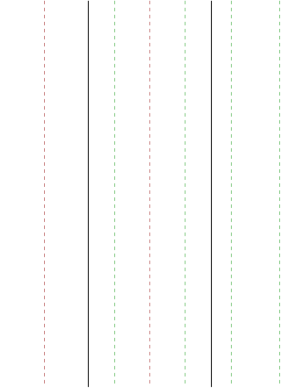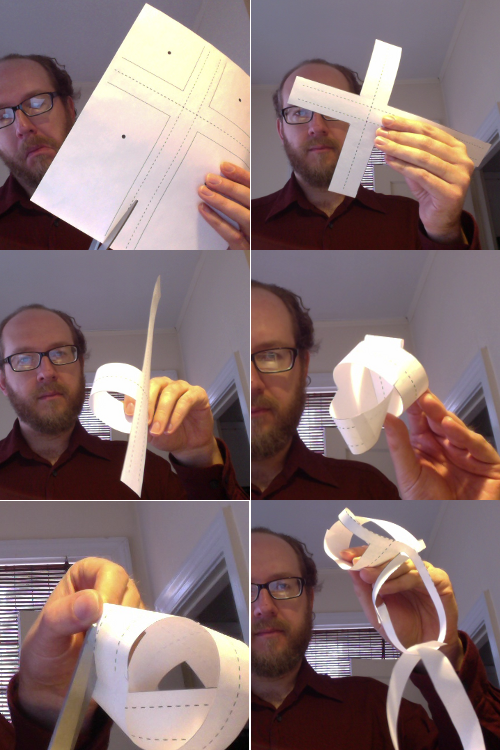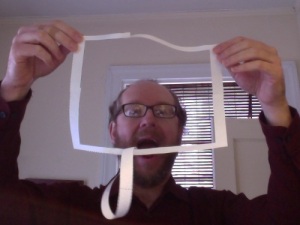
What happens if you cut a Möbius strip down the middle? What happens if you take the result of that cutting, and cut that down the middle? What happens if you cut a Möbius strip in thirds? I won’t tell you the answers, but I’ll give you a template you can print out to figure it out on your own. (A Möbius strip is a surface with only one side, which you can create by taking a strip of paper, twisting it halfway, and attaching the ends together. If you don’t know or remember how to make a Möbius strip, take a peek at this earlier post.)
The first thing to note is that the order of cutting makes a big difference: if you cut along the dashed lines before you make the bands of paper them into Möbius strips, you’ll just end up with a bunch of smaller strips of paper, which is boring. However, if you make Möbius bands first, cutting along the dotted lines does something different in each case. Questions for you: is the result one or more Möbius strips? Are they linked or unlinked?

Now let’s do something similar to a paper Klein bottle: a closed surface with no inside. Strictly speaking, we can’t make Klein bottles in the real world, since they would require passing paper through paper without making any cuts. However, we can make a nice representation of one with paper, as this earlier post describes. This representation starts with a cross-shaped piece of paper; we’ll tape the shorter arms together without twisting, while the longer arms will have one half-twist to make a Möbius strip. Your imagination needs to supply the rest to turn it into a “bottle”, but it’s good enough for most purposes.
Now we’ll cut the long twisted segment into thirds, followed by cutting the short untwisted segment in half. [Update: I had that order reversed in the first version of the post.] Again, I’ve got a template for you on the left, and a photocomic below that might also help a little bit…with the last step missing, so you have to work it out for yourself.

Congratulations! You just did math!
Math and its discontents
Well, you did something that is best interpreted in a mathematical way. I didn’t create any of the exercises above; the last one in particular comes from Martin Gardner, who for years wrote a recreational mathematics column. The puzzle offers four possible solutions to the reader:
- Rectangular frame with Möbius strip attached.
- Five interlocked Möbius strips in a closed chain
- Right triangle with Möbius strip attached
- Large loop with two Möbius strips attached
(If you want to cheat, the solution is at the bottom of the post, but I hope you’ll play the game anyway.)
Maybe I’m being optimistic, but I think most of us enjoy puzzles like this. However, hardly a day goes by where I don’t see a meme or comment calling math “evil” or expressing personal hatred for math. These comments often come from people who graduated from school long since, and a few even come from teachers in non-math fields. That doesn’t even get into the gendered and racial problems with math phobia: the not-so-subtle messages that girls shouldn’t like math, and that “Asian” (defined stereotypically) kids have an inherent knack for it, so why should others even bother? Even I sometimes feel like I have to make apologies for using math terminology.
But you know what? This is all stupid. Let’s all agree right now to stop hating on math. When you hate on math, a kitten dies. Think of the kittens, people!
First, we have to get over the idea that math is “for” some people and not others, wherever you draw that line. As a variety of studies have shown, mathematical ability has less to do with gender or race, and a lot more to do with perseverance. (Seriously, read that link. It’s important.) Next, we have to get past the notion that speed matters. Some people will be faster at math than others, but that’s not a reflection on inherent ability. That’s like saying a fast typist is a better writer than someone who hunts-and-pecks. I’m in the tortoise camp, so I’m on your side if you’re slow too. I’m not qualified to talk about math pedagogy, how it’s done right and wrong, but our attitude toward learning math needs to change, for the sake of reaching and inspiring more students if nothing else.
Finally, as my examples beginning this post were intended to show, math is a huge field, encompassing many different topics. Those paper models were inspired by topology, which you were unlikely to learn in school, at least if your education was like mine. The math I’ve done is largely focused on equations describing physics, which covers a broad range of topics, but without the depth a mathematician might go into.
You don’t have to know or be interested in all of math to love parts of it, and you can understand more of advanced topics than you might think. Many people mean “high school algebra” when they say “math”, but let’s face it: what we learn in high school is to math what cooking rice is to being a chef. The joy of math is in the sauces: topology, number theory, higher geometry, fractals, and so many more. Recreational math, which owes a lot to Lewis Carroll, is well represented by a number of popular books and writers.
A lot of non-mathematicians love number theory, especially the different kinds of infinity and stuff like prime numbers. Evelyn Lamb wrote a fun post this week about how to multiply numbers very quickly on your fingers — even if you only have eight fingers, like characters on The Simpsons. (Look up “surreal number” sometime, if you want a bit of fun.) The classic book Gödel, Escher, Bach is a challenging masterpiece of number theory, art, computer science, and music, rolled into one glorious mess.
Topology of course is another subject that’s easy to approach without fear; I’ve written several posts about it in different guises. Cat-obsessed physicist Greg “Dr. Skyskull” Gbur has written about the hilariously named “hairy ball” theorem, which is an important result in topology that has many applications in physics.
And the list goes on! Chaos theory, which is an interdisciplinary study heavily based in mathematics, has become standard in so many parts of science that it’s hardly considered a separate field anymore. Applications of math to physics, biology, chemistry, and other sciences allow for people to love math without ever really being mathematicians. Jennifer Ouellette’s book, The Calculus Diaries, is a great place to start to see how math applies to a lot of examples in daily life.
So love math. Have fun with it. Don’t fear it, and don’t think there are mathy and non-mathy people. And stop posting anti-math memes. The kittens will thank you.
Spoilers!
Finally, if you really want to know the solution to the sliced-and-diced Klein bottle, here it is:


2 responses to “Don’t fear the math”
On the Klein bottle one, you either made a mistake in the instructions&diagram or in your cutting. In the photo at the bottom there’s a clearly visible dotted line which you failed to cut. Whoops! Fully cutting the dotted lines would have yielded a frame and an unconnected simple rectangular strip.
Yes, I did make a mistake in the instructions – thank you! You should cut the twisted section into thirds first before cutting the untwisted section.The whole thing is also described in this New York Times piece: http://wordplay.blogs.nytimes.com/2013/10/21/martin-gardners-big-surprise/?_r=1